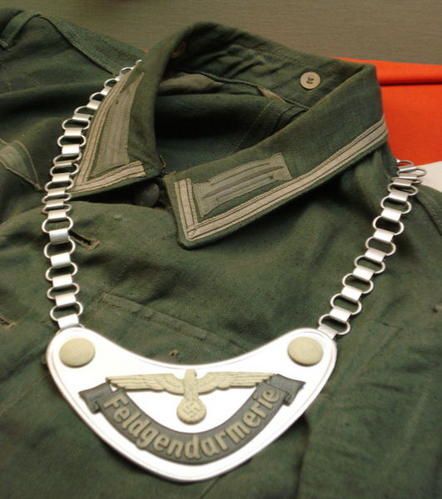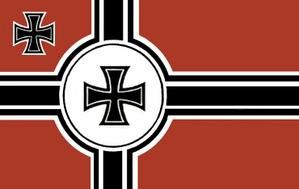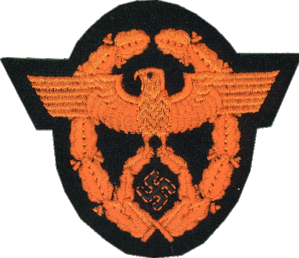| 
The roots of military police in the German armed forces can be traced back to the "Proffoss"of the 16th Century, and the creation of the Feldjagerkorps zu Pferd (shortly changed to Reitendes Feldjagerkorps) by Friedrich II in 1740. The primary duties of the Reitendes Feldjagerkorps were to control traffic, to carry important messages, and to protect members of the royal family. Springing from this band was the Feldjagerkorps zu Fuss (1741) which served both in the Napoleonic Wars and the Franco-Prussian War.
At the beginning or W.W.I the German Army had 33 companies of Feldgendarmerie, made up of about 60 men and NCOs each. Before the war ended this was expanded to 115 units, but they were all disbanded at the end of the war.
After World War I all military police units were disbanded and no police units existed in the post-war Reichswehr. Only garrison areas were patrolled by regular soldiers which was a function normally carried out by military police. The start of W.W.II opened the floodgates for numerous police formations to form and characterised the sometimes chaotic hierarchy of the German armed forces. Civilian police units would form the basis for the Fallschirmtruppen as well as a number of Waffen SS divisions too with at least two well known commanders Sepp Dietrich and Kurt Meyer of the 12th SS serving as policemen prior to joining the military.
Within the German Army of the Third Reich, the "Feldgendarmerie" (also known as "Kettenhunde" or "Chain Dogs") was a military organisation that had received full infantry training and yet had extensive police powers. These military police units were employed with army divisions and higher formations. "Feldgendarmerie" establishments provided various different detachments which were self-contained units under the command of an army division. They worked in close cooperation with the Secret Field Police ("Geheime Feldpolizei") and with district commanders and town majors. 
In Potsdam there was a military police school set up for the purpose of training military police and the subjects taught in these schools were as follows: Criminal code, general and special police powers, forestry, fishery and waterway codes, traffic codes, industrial codes, reporting duties, passport and identification duties, folk culture, first aid, weapons drill and insturction, shooting, defence techniques, criminal police methodology, identification service and general correspondance training. As well as all this there were also lessons in air defence, animal protection and typewriter and stenography courses.
After the first term of examinations, a provisional spell at a police station followed. All courses lasted one year and after completion many of the candidates who failed to make the grade were dropped. It was no mean feat passing out of these schools and becoming police officers-for example of one batch of trainess numbering 219 only 89 remained to take the final exam.
German Feldgendarmerie served right from the outbreak of war and after the occupation of Czechoslovakia and Poland training schools were set up in Prague and Litzmannstadt-G鰎nau as well as a Technical Police School in Berlin. After the war, it was at these schools that most prospective police candidates received their instruction. They served on every front in the war and towards the end were more often employed as regular troops on the front-line and were involved in many desperate counter attacks and defences. Many were decorated for bravery. During the last days of the war all Feldgendarmerie caught by the Soviets (who had offered a bounty for their capture) could expect to be shot on the spot and many were issued with a second Soldbuch (paybook) and matching ID dog tags. In an area where it was fairly likely that prisoners would be taken the Feldgendarm would hand their real paybook into the Felgendarmerie redirection Centre and would receive the false book and tags, which would state the soldiers status as a regular soldier. After the hostilities their real paybook and tags would be returned to them. The organisation of the Feldgendarmerie began at the German High Command O.K.H (Oberkommando Des Heeres). Here a Feldgendarmerie officer of the rank of General Major was directly sub-ordinated to the Quartermaster General. He held ultimate jurisdiction over the Feldgendarmerie units in the Wehrmacht, and was responsible for postings and personal administration, monitoring the performance of the police, allocation of tasks, laying down traffic regulations as well as devising training procedures. His immediate subordinates were the staff officers of each Oberkommando Army who was in charge of the Feldgendarmerie Battalion, one or more of which would be attached to each Army. The staff officer was responsible for maintaining order and discipline, traffic control during large scale troop movements and maintaining traffic routes.
Below the Battalion were platoons ("Truppen") which were attached to each Division or Corps. Fg Groups ("Gruppe") were assigned to a field or local command, and separate units or sections could be assigned temporarily to specific duties for support. A typical "Feldgendarmerie" "trupp" attached to an Infantry or Panzer Division would probably comprise: -
3 officers. -
41 NCO's. -
20 men. -
17 Kubelwagen. -
4 trucks. -
6 solo MC. -
4 MC combinations. These battalions were equipped with motorcycles and motorcycle combinations which were armed with MG34 machine guns, Kubelwagens, Field cars such as the Horch 4x4 and 3 ton Opel Blitz lorries and a small number of armoured vehicles as a means of transport. Besides this the Battalion also had a support group consisting of cooks, clerks, a cobbler and armourer. Personal weapons consisted of small arms such as the excellent Walther PP which was designed as a civilian police pistol (PP-Police Pistole) or the Walther PPK which was favoured by officers whereas the Luger PO8 and Walther P38 were used by other ranks. Automatic machine pistols were carried by NCOs and the Kar 98 rifle was issued but was not widely used. The MG34 and 42 were used as vehicle mounted armament for defending road blocks etc.
The rank and file Feldgendarme's tasks would be as follows: -
Traffic Control. -
Maintaining order and discipline. -
Disarming, searching, collection and escort of POWs and stragglers. -
Supervision of civilian population in occupied areas. -
Checking papers of soldiers on leave and in transit. -
Apprehending deserters. -
Prevention of the distribution of air-dropped enemy propaganda leaflets. -
Carrying out street patrols in occupied areas. -
Control of evacuees and refugees during retreats. -
Border control and anti-partisan duties. They also had the authority to pass through road blocks, check points, and secured areas and were allowed to conduct body and property searches and obtain the assistance of any other military or civilian personnel. They also had seniority over every other soldier up to their own rank whatever their branch of service.
Within the occupied areas, the "Feldgendarmerie" had the following functions: -
Traffic control. -
Control duties at ports and airfields. -
Administrative control of aliens and cattle diseases. -
Hunting, fishing, business, agricutural and forestry police duties. -
Police patrol duties. When their parent divisions were advancing the "Feldgendarmerie" followed the combat troops closely and: -
Acted as and established temporary town majors and army straggler's posts. -
Rounded up enemy stragglers and guerilla's. -
Collecteding refugees and prisoners of war (POW). -
Guarded captured booty. -
Ensured that civilian weapons were surrendered. -
Were responsible for the organisation of civilian labour -
Erected military and civil signs In the home areas of the German Reich they were responsible for: -
Discipline amongst troops -
The rounding up of deserters -
Military traffic control -
Marshaling refugees -
The evacuation of prisoners At the war's end many Feldgendarmerie, specifically those who had not fallen into Soviet hands, found themselves assigned to police roles by the Allies. This happened on a few occasions and an officer of the 101st Airborne Division recalls assigning Feldgendarmerie to guard German officers who had been ordered to take charge of German prisoners of war. Another account goes one further and recalls the British 8th Corps based in Schleswig-Holstein forming an entire regiment of Feldgendarmerie to maintain discipline and order in the Demobilisation Centre at Meldorf. Four battalions and a regimental staff battalion, this Feldgendarmerie-Regiement Krps contained all volunteers, some of whom were ex-police personnel. They wore an armband as identification which bore the legend "Wehrmactordnungstruppe" (Armed Forces Order Troop) and below this read "Military Police". They were all armed and payment for their services came in the form of increased rations. |



![]()





















/idata%2F0396584%2FKOREA%2F71910_korea_MIA1_800.JPG)
/idata%2F0396584%2FU.S.ARMY-POST-WW2%2Fphot4901a.jpg)
/idata%2F0396584%2FDRAWINGS-UNIFORMS-WW2%2F30-451-09b-2.jpg)
/idata%2F0396584%2FP-40%2F44FS000.jpg)
/idata%2F0396584%2FGERMAN-U-BOAT%2FBundesarchiv_Bild_101II-MW-1031-28-_Lorient-_U-31.jpg)
/idata%2F0396584%2FSOVIET-ARMY-WW2%2F1.jpg)






